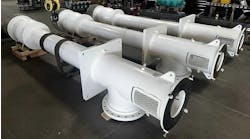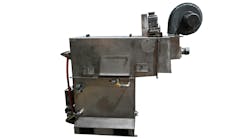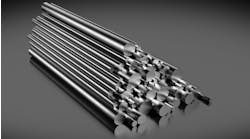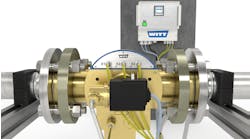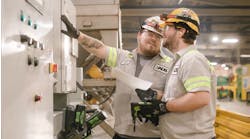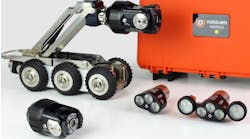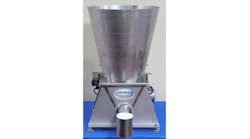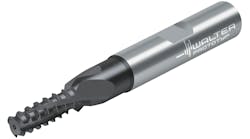For more than 80 years, this magazine has showcased the latest and most useful equipment we think will help your plant, factory, or other industrial operation more efficient. Back in the '30s, it was machinery to drag the country out of the Great Depression and gear up for an inevitable World War. In the 1950s, it was to build highways. In the '60s, to the moon. Now, a lot of ink is dedicated to advanced manufacturing, featuring tools like 3D printers, IoT devices, and robots.
Like most people, we don't always understand the full engineering details on how these components can work together to create a robot spider to 3D-print a fuselage, but we get the gist. And we can touch the finished product and maybe even fly in it someday.
Here, we are taking a step away from all of that space-age hardware and featuring a subject that by all rights should be far dryer: workflow automation.
"When you talk about process automation, it's not the sexiest thing in town, right?" Ryan Duguid states bluntly in a blended Kiwi/ Scottish accent.
In most cases, that should be true. But Duguid is changing that perception.
Duguid is the Senior Vice President of Technology Strategy at Nintex, an 11-year-old company that juices up business workflows with artificial intelligence to replace manual and paper-based processes.
Don't worry. I'm not going to explain how it works, partly because I still don't quite understand, but mostly because it's way more important to tell you what it does.
Like any of the tens of thousands of tools we've written about, Nintex Workflow Cloud makes workers more efficient. Duguid says it can boost the effectiveness of "middle-of the road performers" by 10 to 20%.
This isn't some Matrix scenario where the AI "Agent Smiths" your line worker and controls them for a part of the day.
No, it's more like Moneyball, where boring analytics, derived from those seemingly mundane digital workflows, create tangible results.
It's really not unlike additive manufacturing. You stare at it for a few minutes and nothing really happens, but after a day, you have a usable part. Each workflow process is like a voxel.
Duguid says the average Nintex customer has 5,000 to 7,000 processes, with the biggest company automating more than 120,000. That's millions of data points going to the Nintex cloud. Using the platform's Hawkeye, accessible in a dashboard view, users have an incredibly powerful tool to solving their company's biggest problems.
"With it, you can look for patterns of behavior, highlight potential issues or bottlenecks, and suggest alternative courses of action," Duguid says.
He lobbies that focusing on gradual improvements for several small processes may provide more value than spending a big chunk on one high impact problem.
"You have to solve all those problems, but the COO or plant manager, while they were [worrying about high level issues], there were 10,000 other processes happening every day that they thought were too small to worry about," Duguid says.
These small processes can range from human resources tasks such as speeding up the onboarding of new employees through automatic escalations, to automating the repair process when a refrigeration unit goes down.
If death by 1,000 cuts is worse than one fatal blow, wouldn't 1,000 small cuts to your process time be preferable to one large slash?
And the data, which he stresses Nintex "anonymizes the hell out of," is collected from the breadth of Nintex's ecosystem, and can be leveraged for further insights to identify inefficiencies, or measure how your company performs compared to the rest of your industry.
The manager or executive can drill down even more and filter by country or state.
While all of this sounds very complicated and involves algorithms and machine learning, it really just comes down to optimizing your humans.
Resistance is Futile
"If you eliminate human labor, you eliminate human error," Oracle chairman Larry Ellison announced at the company's recent OpenWorld conference, where the Oracle 18c autonomous database was unveiled.
With soundbites like that, it wouldn't be a shock if you questioned bringing AI into your facility to audit your workforce. But AI isn't a sentient force out to take your job any more than ATMs are maliciously out to take bank tellers' jobs.
Jeremy Bellinghausen has been working with AI for almost 20 years and like most in high tech, staunchly trusts this new digital neural landscape will provide fertile ground for new jobs. At one point he worked for Yellow Pages, once a Bible-like tome for businesses.
"The attitude there was just hold on to this model," Bellinghausen recalls. "We're going to make better books and smaller books and books that fit in your glove compartment and people can use it on the go."
Now, of course, the Yellow Pages are just something you trip over on your front steps once a year.
Currently, he's the COO of Owler, a web platform that mines the web for articles, reviews, and surveys to update company profiles that include revenue, number of employees, and CEO approval rating.
At the dawn of civilization, there used to be two jobs: hunters and gatherers, Bellinghausen argues. "Now everyone here at Owler is working in jobs in an industry that didn't even exist before I was born."
Despite the overwhelming investment (as much as $40 billion in 2016), McKinsey Global Institute says 41% of firms are uncertain about the benefits of AI.
And that just takes Bellinghausen back to the lessons learned from the Yellow Pages: "If your plant is not using these technologies, others still will, and they'll out-compete you."
He says he understands people's apprehension, but the time for that is long gone.
"More old jobs will be going away," he admits. "It's really about training and learning how to work with rather than against the technology."
Over at Nintex, Duguid is busy trying to find ways for AI and machine learning to help boost people the same way other 21st century tech like smartglasses and industrial exoskeletons.
When I asked if Hawkeye could be used in a gamification model to reward high performers for exceeding benchmarks, as opposed to weeding out the underperformers, he said the idea was totally possible.
"There's nothing to stop you from doing it, he says, "There's your counter to finding your worst people—a way to celebrate your best people and drive performance."
As with any tool in the plant, even AI is only as smart as the people using it.
"It's what you choose to do with the information that matters," Duguid says.
